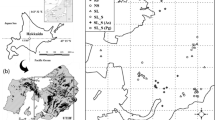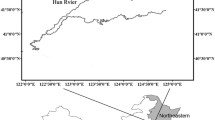Abstract
The restoration of forest landscape has drawn much attention since the catastrophic fire took place on the northern slope of Great Hing′an Mountains in 1987. Forest canopy density, which has close relation to forest productivity, was selected as a key factor to find how much the forest quality was changed 13 years after fire, and how fire severity, regeneration way and terrain factors influenced the restoration of forest canopy density, based on forest inventory data in China, using Kendall Bivariate Correlation Analysis, and Distances Correlation Analysis. The results showed that fire severity that was inversely correlated with forest canopy density grade was an initial factor among all that selected. Regeneration way which did not remarkably affect forest canopy density restoration in short period may shorten the cycle of forest succession and promote the forest productivity of conophorium in the future. Among the three terrain factors, the effect of slope was the strongest, the position on slope was the second and the aspect was the last
Access this chapter
Tax calculation will be finalised at checkout
Purchases are for personal use only
Preview
Unable to display preview. Download preview PDF.
Similar content being viewed by others

References
Bergeron, Y. and Brisson, J. (1990). Fire regime in red pine stands at the northern limit of the species range. Canadian Journal of Forest Research, 17, 129-137
Garren, K. H. (1943). Effects of fire on vegetation of the Southeastern United States. Botanical Review, 9(3), 733-736.
Gill, A.M. (1975). Fire and Australian flora: a review. Australian Forestry, 38 , 1-25.
Grogan, P., Bruns, T.D. and Chapin, F.S. (2000). Fire effects on ecosystem nitrogen cycling in a Californian bishop pine forest. Oecologia, 122 (4), 537-544.
Guan, K.Z. and Zhang, D.J. (1989). Influences analysis of forest fire on Daxinganling Mountains on vegetation. Environmental Science, 11 (5), 82-88.
Kong, F.H., Li, X.Z. and Wang, X.G. (2003). Advance on Study of forest restoration in the burned blank. Chinese Journal of Ecology, 22 (2), 60-64.
Li, F.Z., Zheng, H.Y. and Lu, Y.B. (1988). Effects of catastrophic forest fire in the Great Xingan Mountains on soil microorganisms. Chinese Journal of Ecology, 7 (suppl.), 60-62.
Liu, G.H. and Fu, B.J. (2001). Effects of global climate change on forest ecosystem, Journal of Natural Resources,16 (1), 71-78.
Luo, J.C. (2002). Influence of forest fire disaster on forest ecosystem in Great Xing’anling. Journal of Beijing Forestry University, 24 (5/6), 101-107.
Nakagoshi, N. (2001). Forest fire and management in pine forest ecosystem in Japan. Hikobia, 13, 301-311.
Pianka, E. (1992). Disturbance, spatial heterogeneity, and biotic diversity: fire succession in arid Australia. Res. Explor, 8, 352-371.
Shen, Z.H., Zhang, X.S. and Jin, X.Y. (2000). Gradient analysis of the influence of mountain topography on vegetation pattern. Acta phytoecologica Sinica, 24 (4), 430-435.
Turner, M.G., Romme, W.H., Gardner, R.H. and Hargrove, W.W. (1997). Effects of fire size and pattern on early succession in Yellowstone National Park. Ecological Monographs, 4 (67), 411-433.
Wang, X.G. and Li, X.Z. (2003). Model of vegetation restoration under natural regeneration and human interference in the burned area of northern Daxinganling. Chinese Journal of Ecology, 22 (5), 30-34.
Weaver, H. (1951). Fire as an ecological factor in the southwestern ponderosa pine forest. Journal of Forestry, 49, 93-98.
Xiao, D.N., Tao, D.L., and Xu, Z.B. (1988). Impacts of an extraordinarily disastrous fire on forest resources and environment. Chinese Journal of Ecology, 7 (suppl), 5-9.
Xu, H.C. (1988). Da Hinggan Ling Mountains Forests in China(pp. 7-21). Beijing, Science Press.
Yang, S.C., Liu, X.T. and Cao, H.B. (1998). 1994. Vegetation change on burn blank in Da Xing’anling forest area. Journal of Northeast Forestry University, 26 (1), 19 - 22.
Zhao, D.C. (1988). Vegetations and their restoration after the disastrous fire in the Great Xingan Mountains. Chinese Journal of Ecology, 7 (sup), 5-9.
Zhao, K.L., Zhang ,W.F. and Yang, Y.X. (1994). The impact on swamp and countermeasure of the fire in the Da Hinggan Mountains analysed by vegetation. In Zhao, K.Y., Zhang, W.F., Zhou, Y.W. and Yang, Y.X. (Eds.). Environmental Influences and Strategies of Forest Fire in Daxinganling Mountains. (pp. 54-63). Beijing, Science Press.
Zhou, M., Yu, X.X. and Feng, L. (2003). Effects of permafrost and wetland in forests in Great Xing’an Mountain on ecology and environment. Journal of Beijing Forestry University, 25 (6), 91-93.
Zhou, Y.W., Liang, L.H. and Guo, Z.W. (1994). Changes of the Hydro-Thermal regime of frozen ground after the forest fire in the Northern part of the Da Hinggan Mountains. In Zhao, K.Y., Zhang, W.F., Zhou, Y.W. and Yang, Y.X. (Eds.). Environmental Influences and Strategies of Forest Fire in Daxinganling Mountains(pp. 25-35). Beijing, Science Press.
Author information
Authors and Affiliations
Editor information
Editors and Affiliations
Rights and permissions
Copyright information
© 2008 Springer Science+Business Media B.V.
About this chapter
Cite this chapter
XIE, FJ., LI, XZ., WANG, XG., XIAO, DN. (2008). Post-Fire Forest Restoration Indicated by Canopy Density in the Northern Great Hing’an Mountains. In: Hong, SK., Nakagoshi, N., Fu, B., Morimoto, Y. (eds) Landscape Ecological Applications in Man-Influenced Areas. Springer, Dordrecht. https://doi.org/10.1007/1-4020-5488-2_21
Download citation
DOI: https://doi.org/10.1007/1-4020-5488-2_21
Publisher Name: Springer, Dordrecht
Print ISBN: 978-1-4020-5487-7
Online ISBN: 978-1-4020-5488-4
eBook Packages: Biomedical and Life SciencesBiomedical and Life Sciences (R0)



